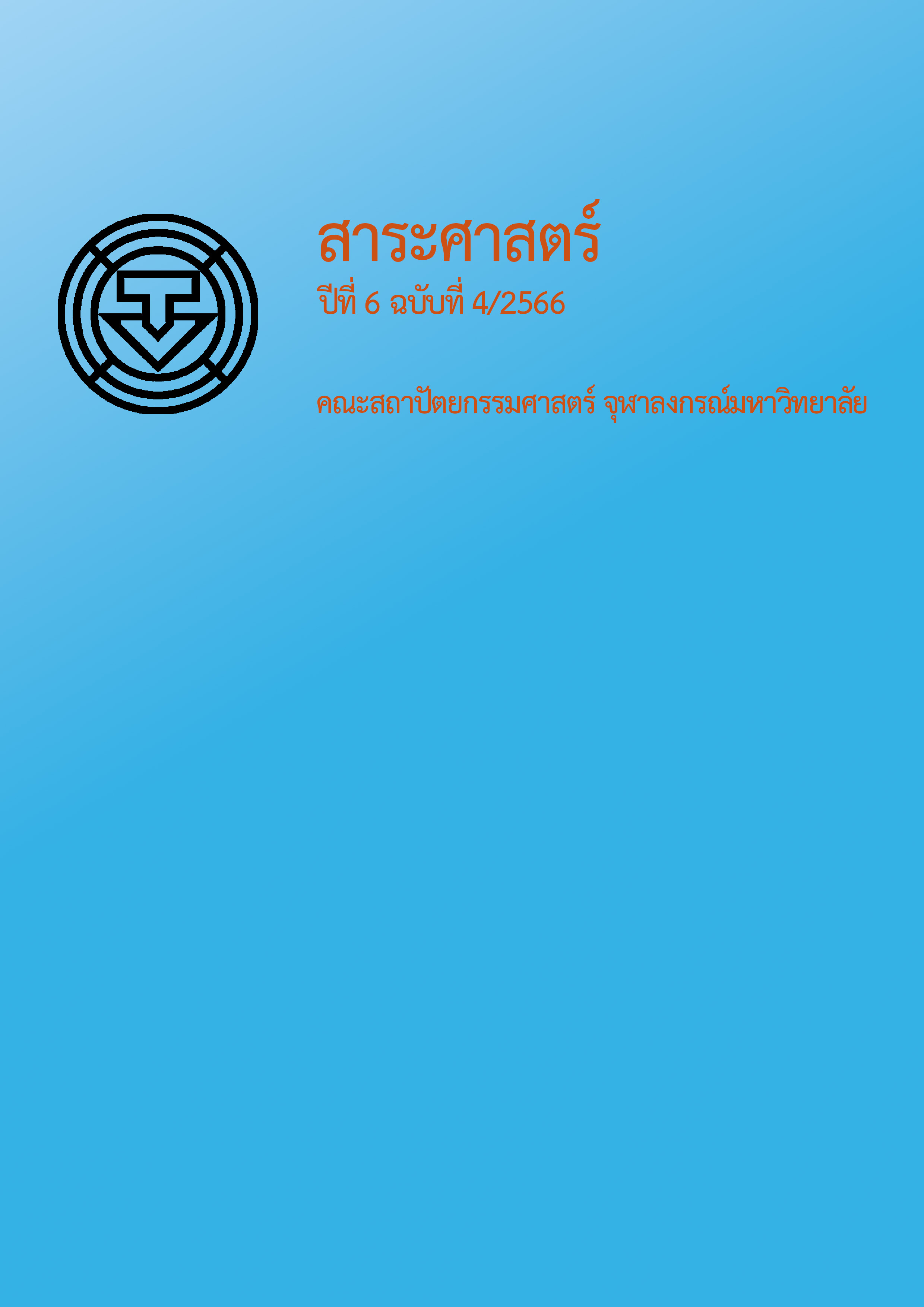Opportunities and Limitations of Implementing Digital Twin Technology in Office Buildings in Thailand from the Expert Perspectives
Main Article Content
Abstract
Digital Twin technology refers to the complete integration of virtual and physical objects that communicate with each other bidirectionally, meaning that the data is automatically linked. In recent years, the Digital Twin technology has gained attention from various industries, including office real estate which incorporates complex space and building service systems. This study aims to explore the current situation and trends in the use of Digital Twin technology, as well as the opportunities and limitations of implementing it in office buildings in Thailand. The research was conducted through a literature review and expert interviews.
The study found that Digital Twin technology is currently in the early stages of research and there is an unclear framework for its implementation. However, there is an increasing awareness of this technology. The most significant opportunities are the use of building simulation for design, and planning of interior spaces within construction projects, business opportunities, and marketing opportunities. When it comes to implementing this technology in buildings, there are limitations that have the most significant impact on its use. These limitations include changing workflows, increased operational costs from sensor usage and additional resource requirements, high operational expenses, lack of technology implemented in the contract, doubts regarding return on investment, lack of support from top-level management, and a lack of demand from customers and government agencies.
This research demonstrates that utilizing Digital Twin technologies in commercial office real estate in Thailand still requires effort from stakeholders to overcome limitations and create an environment suitable for their implementation. Experts suggest the collaboration between government, industrial operators, and educational institutions to develop policies, regulations, and training programs that can support the growth of Digital Twin technology in the real estate sector.
Article Details
References
ซีบีอาร์อี. (2565). แนวโน้มตลาดอสังหาริมทรัพย์ไทยปี 2565. www.cbre.co.th/insights/reports/thailand-real-estate-market-outlook-2022-thai-version
ธงชัย ทองมา. (2553). การบริหารทรัพยากรกายภาพอาคารสำนักงานให้เช่าระดับ เอ : กรณีศึกษาอาคารสำนักงานให้เช่า จำนวน 15 อาคาร ในบริเวณศูนย์กลางเขตธุรกิจกรุงเทพมหานคร [วิทยานิพนธ์ปริญญามหาบัณฑิต ไม่ได้ตีพิมพ์]. จุฬาลงกรณ์มหาวิทยาลัย.
ธณัชชา สุขขี. (2554). การศึกษาการเลือกใช้แบบจำลองข้อมูลอาคารสำหรับอุตสาหกรรมก่อสร้างในประเทศไทย [วิทยานิพนธ์ปริญญามหาบัณฑิต ไม่ได้ตีพิมพ์]. มหาวิทยาลัยศิลปากร.
วิจัยกรุงศรี. (2564). แนวโน้มธุรกิจ/อุตสาหกรรม ปี 2564-2566 : สำนักงานให้เช่าในกรุงเทพฯ และปริมณฑล. www.krungsri.com/th/research/industry/industry-outlook/real-estate/commercial-buildings-in-bmr/io/io-office-building-in-bmr-21
สมาคมสถาปนิกสยาม ในพระบรมราชูปถัมภ์. (2558). แนวทางการใช้งานแบบจำลองสารสนเทศอาคารสำหรับประเทศไทย (Thailand BIM guideline). https://asa.or.th/handbook/handbook20150427/
โอภาส เอี่ยมสิริวงศ์. (2558). ระบบฐานข้อมูล Database systems. ซีเอ็ดยูเคชั่น.
Botín-Sanabria, D. M., Mihaita, A.-S., Peimbert-García, R. E., Ramírez-Moreno, M. A., Ramírez-Mendoza, R. A., & Lozoya-Santos, J. D. J.(2022). Digital twin technology challenges and applications: A comprehensive review. Remote Sensing, 14(6), 1335.
Dave, B., Buda, A., Nurminen, A., & Främling, K. (2018). A framework for integrating BIM and IoT through open, standards. Automation in Construction, 95, 35-45.
Eyre, J., & Freeman, C. (2018). Immersive applications of industrial digital twins. file:///C:/Users/User/Downloads/EuroVR2018_Paper5.pdf
Glaessgen, E., & Stargel, D. (2012, April 23-26). The digital twin paradigm for future NASA and US Air Force vehicles [Conference presentation]. The 53rd Structures, Structural Dynamics, and Materials Conference: Special Session on the Digital Twin, Honolulu, Hawaii.
Khajavi, S. H., Motlagh, N. H., Jaribion, A., Werner, L. C., & Holmström, J. (2019). Digital twin: Vision, benefits, boundaries, and creation for buildings. IEEE Access, 7, 147406-147419.
Lee, D., Cha, G., & Park, S. (2016). A study on data visualization of embedded sensors for building energy monitoring using BIM. International Journal of Precision Engineering and Manufacturing, 17(6), 807-814.
Menassa, C. C. (2021). From BIM to digital twins: A systematic review of the evolution of intelligent building representations in the AEC-FM industry. Journal of Information Technology in Construction (ITcon), 26(5), 58-83.
Natephra, W., & Motamedi, A. (2019). Live data visualization of IoT sensors using augmented reality (AR) and BIM [Conference presentation]. The 36th International Symposium on Automation and Robotics in Construction (ISARC 2019), Banff, Canada.
Neto, A. A., Deschamps, F., da Silva, E. R., & de Lima, E. P. (2020). Digital twins in manufacturing: An assessment of drivers, enablers, and barriers to implementation. Procedia Cirp, 93, 210-215.
Pourzolfaghar, Z., McDonnell, P., & Helfert, M. (2017, November 23-24). Barriers to benefit from integration of building, information with live data from IOT devices during the facility management phase [Conference presentation]. CITA BIM Gathering, Dublin, Ireland.
Tang, S., Shelden, D. R., Eastman, C. M., Pishdad-Bozorgi, P., & Gao, X. (2019). A review of Building Information Modeling (BIM) and the Internet of Things (IoT) devices integration: Present status and future trends. Automation in Construction, 101, 127-139.


